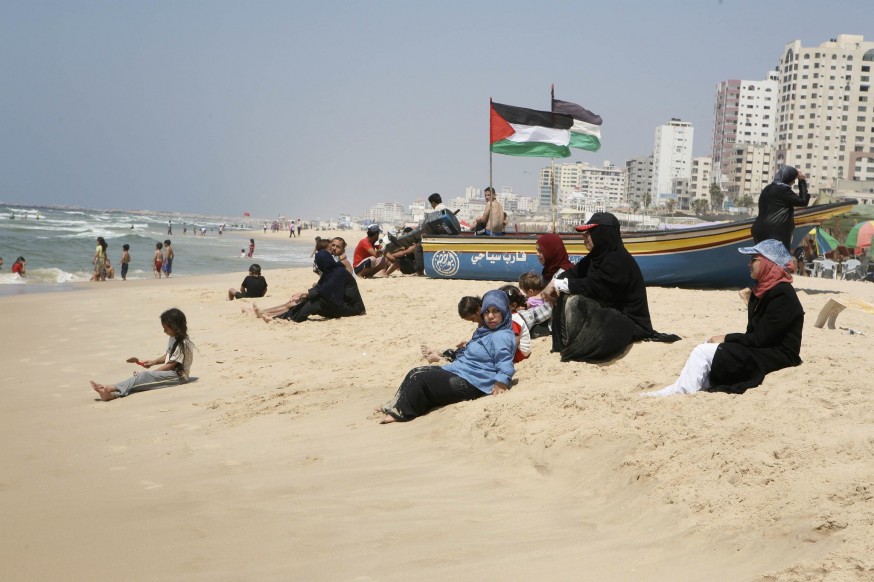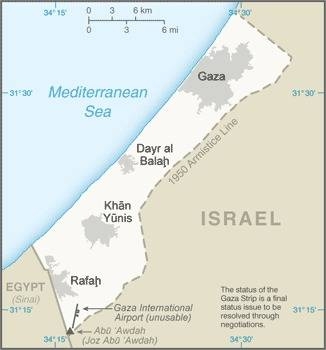The Gaza Strip | IMEU Policy Backgrounder

Palestinians at the beach at Gaza City. Photo credit: Stitching Kefaia/Flickr. Creative Commons license.
- The Gaza Strip is a small portion of the southwest of historic Palestine (approximately one percent) bordering Egypt to the south, the Mediterranean Sea to the west, and Israel to the north and east. According to the Central Intelligence Agency Factbook, it is 360 square kilometers (roughly twice the size of Washington, DC) and as of July 2021 had an estimated 1.975 million residents.

Map: Central Intelligence Agency Factbook. - During and after the 1948 war, which resulted in the establishment of Israel and the ethnic cleansing of Palestine (known in Arabic as the Nakba, or “catastrophe” in English), the Israeli military exiled many Palestinians to the Gaza Strip and denied them their right of return to their homes afterward. Noted historian Nur Masalha states in The Palestine Nakba that Palestinians from the village of al-Majdal (today the Israeli city of Ashkelon) were still being expelled from their homes and “loaded onto trucks and dropped off at the border” with the Gaza Strip as late as October 1950. Today, approximately 70 percent of Palestinians in the Gaza Strip are refugees.
- Following the 1949 Israeli-Egyptian armistice until the 1967 war, the Gaza Strip was under Egyptian administration. However, Israel occupied the Gaza Strip for five months during and after its 1956 attack on Egypt, and committed at least two massacres of as many as 275 Palestinians in Khan Younis and 111 in Rafah during this time. However, the Israeli archives about these massacres are still classified and much is still unknown. Israel ended its military occupation of the Gaza Strip in March 1957 as a result of pressure by the Eisenhower administration to force Israel back to its 1949 armistice lines.
- During the 1967 war, Israel again occupied the Gaza Strip, a military occupation which endures to this day notwithstanding Israel’s unilateral withdrawal of settlers and soldiers from within the Gaza Strip in 2005. As it did in the West Bank, including East Jerusalem, Israel also colonized the Gaza Strip with Jewish-only settlements. Until 2005, approximately 7,000 Israeli settlers lived in 16 settlements within the Gaza Strip. Despite these relatively small numbers, these settlement blocs similarly fragmented Palestinian space in a way comparable to today’s settlements in the West Bank. According to Saree Makdisi in Palestine Inside Out: An Everyday Occupation, “over a third of the entire territory was reserved for the exclusive use of the 1 percent of Gaza’s population that was Jewish. The rest of the Strip was broken and truncated, punctuated by roadblocks and checkpoints and frequent curfews and closures.”
- Israel unilaterally withdrew its illegal settlements and army posts from within the Gaza Strip in 2005, but maintained its military occupation by exercising effective control from without and imposing a land, sea, and air blockade after the 2006 Palestinian legislative election. Despite Israel and the United States encouraging these elections, they did not accept their results. Instead, the Bush administration, as reported by Vanity Fair, financed the training of Fatah forces designed to trigger a civil war against Hamas, leading to the split in the Palestinian Authority (PA) which exists to this day. Israel’s ongoing blockade of the Gaza Strip has been decried as an illegal act of collective punishment by the UN Special Rapporteur on the situation of human rights in the Palestinian Territory occupied since 1967.
- After Israel’s unilateral withdrawal from the Gaza Strip, it signed an agreement with the PA to maintain open travel and economic relations between the Gaza Strip, the West Bank, and other countries. Therefore, Israel’s ongoing blockade of the Gaza Strip is also a violation of the Agreement on Movement and Access, signed between Israel and the PA, and brokered by the United States. In this agreement, Israel pledged the continuous functioning of Gaza’s border crossing with Egypt, regular transit of people and goods between the Gaza Strip and West Bank, the construction of a seaport for the Gaza Strip, and other pledges which have gone unfulfilled.
- Israel’s blockade of the Gaza Strip has created a humanitarian catastrophe. Israel’s blockade of the Gaza Strip negatively impacts every facet of life for Palestinians in the Gaza Strip in 2021. According to the UN Office for the Coordination of Humanitarian Affairs, 37 percent of applications for Palestinians to receive exit visas for medical treatment were delayed or denied by Israel. Palestinians had access to only 80 percent of the minimum WHO recommendation for water. 75 percent of Palestinians purchased food of reduced quality, reflecting widespread food insecurity. Palestinians had access to only 13 hours of electricity per day. 9,000 internally displaced Palestinians are still in need of housing reconstruction from previous Israeli attacks. It is important to note that this humanitarian catastrophe is a result of the policies of the Israeli government. Shortly after Israel’s imposition of its blockade, a senior government adviser crudely admitted that Israel’s policies were “to put the Palestinians on a diet”.
- Israel’s repeated attacks against the Gaza Strip have deliberately targeted civilians and civilian infrastructure, often with US weapons, which have resulted in international investigations finding that Israel may have committed war crimes and potential crimes against humanity. Since 2008, major Israeli attacks on the Gaza Strip have killed more than 4,000 people, the majority of whom were civilians, and injured many more. In addition, in 2010 Israel killed 10 activists in international waters who were attempting to break its sea blockade of the Gaza Strip and deliver humanitarian goods to it. Often utilizing US weapons such as F-16 fighter jets, Apache helicopter gunships, missiles, and bulldozers, international investigations and human rights reports have concluded that Israeli forces have targeted civilians and civilian infrastructure, and have employed disproportionate and indiscriminate force, in the process committing potential war crimes and crimes against humanity. Despite this, the United States has failed to hold Israel accountable and continues the flow of weapons despite obvious and repeated violations of US laws.
Learn More
- Why Israel Must Be Held Accountable for Policies toward the Gaza Strip, IMEU, January 2022
- Putting Palestinians “On a Diet”: Israel’s Siege & Blockade of Gaza, IMEU, August 2014
- We Are Not Numbers
